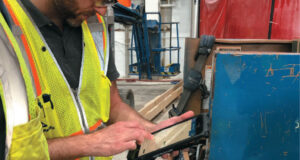ROBERT CANNON
I was in graduate school studying kinesiology and ergonomics when I was invited to a dance performance. I was enthralled by the beauty of the movement and the extraordinary skill. But, I learned it came with pain, a lot of pain. I was hooked. I wanted to be involved. I began by working in theatre including Broadway, music, film and television, and on to industry, every kind of industry. Interestingly, all faced the same ergonomic issues; they just did different things with different motivations.
In my 38 years of consulting, I find that people basically fall into three motivational categories.
The first are individuals who rely on their bodies for their careers. These are the dancers, musicians, craftsmen, and athletes, many of whom have no fallback when injury occurs and often no workers’ compensation. Worse, when an injury does occur, there is the fear that improper technique or overuse may actually end careers. These people are information sponges. Recommendations given are followed with dedication. Recovery is typically fast and recurrence reduced or eliminated because they quickly change their ergonomic behavior.
The second group, the majority, try every day to do their best. They pursue a healthy lifestyle. They’ve had their share of sports, work, or home injuries and want to avoid them. They listen to professional advice and follow the plan…if it makes sense to their lives. They consider how recommendations relate to what they do and their personal injury history. Typically, if you offer straightforward ergonomic training, easy to remember and apply, you will get buy-in. If it goes well, they will teach what they learn to each other and their families.
I describe the third group as classic CAVE people: Citizens Against Virtually Everything. They are usually a small, but frequently vocal group. They view injury as “part of the job” or think of themselves as “accident prone.” No matter what they do, they always seem to get hurt. Maybe they gradually give up and eventually, although they’re not happy about their injuries, they keep doing what they do without interest in advice offered.
Still, they can be reached.
I begin every training by demonstrating how bodies work. People universally like that. They want to know “what’s under the hood,” so to speak. Then, we talk about why injury occurs. It could be an acute injury, like a fall or strain, or it could be something that takes time to develop, that sneaks up on you until suddenly you have pain.
Happily, acute injuries are mostly preventable. We aren’t looking or thinking, just for a moment, then oops…you fall or over-exert. Usually we know exactly what we did wrong the moment it happens. Looking at or thinking about what we are doing typically gives us a chance to avoid making mistakes.
Then there’s that “sneaks up on you” injury. If you do something over and over again without stretching or taking a rest, your muscles, ligaments, and tendons will break down. It’s like bending your credit card over and over until it breaks.
We need to recognize when we’re doing something repetitive and stop. If we can’t stop because it’s what we do as a musician, dancer, or factory worker, then we need to know how to reduce or eliminate accumulated stress. We need to make sure that everything we do is correct, ergonomically speaking, so we don’t break down even faster.
If an ergonomic program is going to stick it must be fun, fast, and interactive, and apply to what we do. Here’s an example.
I’ve worked with longshoremen for 17 years. I recall one training session where no one was interested in what I had to say. They were told to be there and they were, but that’s it. Then, we started just talking to each other. We eventually got to what was important to them; there were two things in particular, one surprising. They wanted to be able to play with their grandkids… and play cricket. Who knew?! This group was of British and East Indian origin. They loved watching and playing cricket. We spent the entire session talking about cricket injuries and how to avoid them. They were a captive and motivated audience. I have no idea about cricket, but I know how the body works. They showed me the movements and I showed them how to avoid injury. When we finished and they went back to work I knew they would be able to apply what we’d talked about to what they did at work and while playing with their grandkids. Make it relevant and they’ll listen.
The most important success factor is company support. This includes recognizing the impact of human factors on personal ergonomics. Even if the workforce understands and practices proper ergonomics, consider how rushing, frustration, fatigue, or complacency can lead to bad ergonomic choices. This is the necessary conversation on the floor.
Of course, be sure to reinforce ergonomic best practices by storytelling and analyzing past occurrences to ensure successful future avoidance. Track improvements so everyone can see the results of their collective efforts.
Robert “Doc” Cannon is an ergonomics specialist with the unique ability to bridge the gap between ergonomics and human error as it relates to injury reduction. He is a SafeStart consultant and author of the very successful “SafeStart for Personal Ergonomics” program.
 Paper 360
Paper 360

